When man meets metal: rise of the transhumans
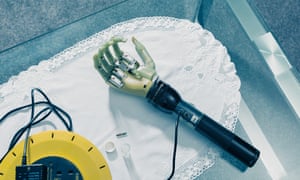
Earlier this year I went to an event in Austin, Texas, billed as a sneak preview of the evolution of our species. The #Bdyhax Conference, which took place in a downtown exhibition complex, promised a front-row insight into the coming “singularity” – that nirvana foretold by science fiction in which biology and technology would fuse and revolutionise human capability and experience.
The headline acts of the conference were mostly bodyhackers – DIY experimenters who, in their basements and garages, seek to enhance their own flesh and blood with biometric implants and cognitive enablers. These brave pioneers were extending their senses, overcoming physical limitation, Dan-Daring themselves and the rest of us into the future.
At least that was the idea. The reality of the convention was a little more mundane. It was overpriced and sparsely attended. Disparate and awkward groups of the pierced and the tattooed wandered between lectures about the ethics of body augmentation, and budget demonstrations of virtual worlds, past stalls flogging various kinds of neurotropic snake oil or enthusing over the transforming possibilities of magnets and LED lights inserted under the skin.
Occasionally, over a long couple of days, there was a genuine spark of wonder – the demonstration of a vest that converted sound into multiple vibrations felt across the back, promising a new way for deaf people to hear; a drummer who had lost an arm, and had customised his own prosthetic that could now play like Buddy Rich; a woman, Moon Ribas, who had wired herself to experience tiny shifts in tectonic plates, and was converting those tremors into choreography.
These latter experiments seemed to exist somewhere between art, medicine and counterculture. They shared a knowledge of the newly understood plasticity of the brain, and a utopian idea of technology, and were pushing that understanding in novel, homemade directions. They were, at least, the most convincing hints that this introverted subculture – which styles itself as “transhuman” – was sometimes knocking at the doors of perception just as determinedly as those early experimenters with hallucinogenic drugs in the last century.
David Vintiner, a British photographer, has been following this subculture for the past two years. He divides his pictures of transhumanists – some of which are reproduced here – into three groups: those who are working to extend life, those toying with implants as body art, and those attempting to make permanent changes to the human condition. The pictures capture precisely the ironies that were on display in Austin, Texas: the odd union between scientific innovators and garden-shed fantasists.
“We set out at the beginning to photograph people in a domestic environment as much as possible,” Vintiner’s collaborator Gem Fletcher tells me. “These things are mostly happening in people’s bedrooms.”

One of the inspirations for Vintiner’s journey into this culture was Professor Kevin Warwick, deputy vice-chancellor at Coventry University, who back in 1998 was the first person to put a silicon chip transponder under his skin (that enabled him to open doors and switch on lights automatically as he moved about his department) and to declare himself “cyborg”. Four years later Warwick pioneered a “Braingate” implant, which involved hundreds of electrodes tapping into his nervous system and transferring signals across the internet, first to control the movements of a bionic hand, and then to connect directly and “communicate” with his wife, who had a Braingate of her own.
In some ways Warwick’s work seemed to set the parameters of the bodyhacking experience: full of ambition, somewhat risky, mostly outlawed. The Braingate system is now being explored in America to help some patients suffering paralysis, but Warwick’s DIY work has not been widely taken up by either mainstream medicine, academia or commercial tech companies. He and his wife remain the only couple to have communicated “nervous system to nervous system” through pulses that it took six weeks for their brains to “hear”. “It was a bit out there,” Warwick told me last week. “And though my papers get cited, I’ve not become a member of the Royal Society, or received any of the normal plaudits.”
If Warwick has cyborg disciples they mostly exist among the bodyhackers, transhumanists and grinders that Vintiner has photographed. “I think they are often the ones now pushing the field,” Warwick says. “Though they are taking a lot of risks sometimes by doing these things in their garage and not a lab.”
Speaking to the people in Vintiner’s pictures, you hear about some of those risks, but also the extent of new technological possibilities – and the current limits to them. We have become used to implants to fix medical problems, for diabetes, for heart conditions. And as a culture we have long accepted the therapeutic possibilities of plastic surgery. But the idea that we might augment our natural senses and abilities through surgery remains a difficult ethical question.
Some of the people that Vintiner has photographed have had their desire for the superhuman thrust upon them. James Young lost his arm and leg in a rail accident in east London in 2012. He subsequently enjoyed a degree of publicity when he won a competition offered by a computer gaming company to receive a bionic arm, laser lit, and with phone-charging ports and a personal drone attachment.
Eighteen months on, Young has mixed feelings about the arm, which he helped to design with London-based prosthetic sculptor Sophie de Oliveira Barata. For all its gadgetry and futuristic style, the arm is heavy to wear and limited in “normal” function. He usually does without it. He is most grateful that the arm has led him into a new career as a TV presenter, partly from the interest it generated. He plans, however, to replace it with a model that can be properly attached to his bone, and eventually integrated with his neural intention.
Though the arm was a great conversation starter – he has been adopted by the transhuman community – Young fears that augmentation will continue to be a marginal interest. Why would tech companies risk surgical solutions, he asks, when externalising technology is much safer and cheaper? “That is why people slice themselves up at home or in tattoo parlours or whatever. The corporate commercial risk is hard to address.”
Rob Spence, the “Eyeborg” tells a similar tale. Nearly a decade ago he replaced the eye he had lost in a childhood accident with a video camera he could use to record and transmit real-time footage of what he was seeing. Spence had grown up on superheroes and wanted to fill the absence in his eye socket with a presence. Again he remains a lone pioneer of the procedure, which he developed and installed with the aid of friends at home. He thinks a squeamishness about the right to privacy of people being recorded is to blame, though he believes people will soon be more comfortable with interventions like his.
“For me, the best example is always breast augmentation,” Spence says. In terms of transhuman additions, “it is like we are in the 60s of boob jobs. When certain kinds of things make people’s lives better, like laser eye surgery or boob jobs, then eventually more people do it. They like not wearing glasses, or they like having larger breasts. We haven’t reached that point yet.”
He sees the eventual integration of tech into our bodies as inevitable: “There is a clear progression. First it was a big room at IBM, then it was your desktop, then your laptop or tablet, then your smartphone – and next the digital will be part of your body. The question, I guess, is at what point would someone lop off their arm and replace it with something bionic? It will get there, but it’s a long way off.”
Over the years, Spence has talked to various commercial companies about developing applications for the eyeborg, but eventually they all backed off. “It is an odd product in that it raises issues both legally and medically,” he says. “People end up seeing it as, at best, an elaborate toy for one-eyed people.”
Neil Harbisson is more messianic about the possibilities of bodyhacking. Harbisson, who lives in Barcelona, was born with a rare ocular condition that only allows him to see colours in shades of grey. He had an antenna fixed into his skull by a surgeon friend in 2006. The antenna translates the colour spectrum into musical notes and transmits the data to Harbisson through bone conduction. He sees colour as sound. Blue is middle C.
He views the antenna as an art project which designs his perception of reality. “It is not the union of two senses but the creation of a new sense,” he suggests, one that allows him to also “see” ultraviolet and infrared light.
Again he encounters a lot of resistance to the idea that he is “improving” his sensory apparatus. “People find it ethical to recreate pre-existing sense and pre-existing body parts,” he says, “but when it comes to new body parts and new sense it is something that people find unnecessary. I think that will change. People will start to see that the best way of improving the planet is to design and improve ourselves. If we all had night vision, for example, we would not have to use artificial light at night. We wouldn’t need to light our cities. The more senses we have, the less energy we will need.”
To advance this cause, Harbisson helped created the Cyborg Foundation, which acts as a reference point for young bodyhackers and transhumanists around the world. He himself feels he has evolved into a post-human condition with the addition of his antenna, which connects him, he argues, more closely with other life forms that share similar cognitive apparatus: bees, for example, which also “see” ultraviolet.
He calls this awareness “transspecies” and compares it to the transgender movement. “We have people who are interested in creating new senses and organs, and people who identify as transspecies are starting to realise they are not alone, though up until now they have not been able to say it aloud, in case people might laugh,” he says.
“We have many of the same problems [as transgender groups]. Bioethical committees did not historically accept transgender surgeries, and in our case they do not accept transspecies surgeries [for people who want augmentation]. They worry about people coming out of hospital with an antenna sticking out of their heads and what it would do to the reputation of the hospital. But that will change…”
In the meantime, there are plenty of less radical possibilities for the “transspecies curious” to experiment with. Some, like Rin Räuber, only want the simple buzz of feeling a magnetic field (and picking up a spoon) with an implant in their finger. “What I do is not rooted in a grand vision for the future of humanity,” Räuber has said. “It’s like a child playing around, saying, ‘Look what I can do, isn’t this cool?’”
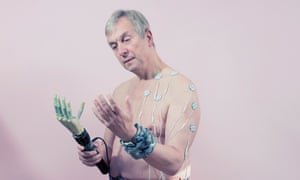
Photograph: David Vintiner
Other experiments are more trippy. The Eyesect helmet created by a German collective called the Constitute uses externally mounted video cameras to allow wearers to experience different species’ perceptions of the world – through the swivel eyes of a chameleon or the long face of a horse.
Christian Zöllner, who helped create Eyesect, insists it is an art project (“made with punk attitude and punk tools”) not a tech-led design. It’s “an aesthetic playground for people to experience and witness the limits of their perceptions.” Users often fall over.
In Mark O’Connell’s recent book-length adventure into the DIY cyborg world, To Be a Machine, he describes transhuman ambition as “an expression of the profound human longing to transcend the confusion and desire and impotence and sickness of the body, cowering in the darkening shadow of its own decay. This longing had historically been the domain of religion, and was now the increasingly fertile terrain of technology.”
The people in David Vintiner’s pictures buy into this faith in different ways. James Young, who sees his “futuristic” arm as the beginning of a journey and not the end, is sanguine about the reality but hopeful about the implications. The day before we speak, he showed his limb to a class of six-year-olds. “They loved it,” he says, “and I was trying not to be too negative. They were saying: ‘Does it make you super-strong?’ And I was like: ‘Not exactly … but if it gets bashed, I can’t feel pain on it.’”
At the very least, bodyhacking futurism acts as an inspiration to others. “I have had lots of people contact me to say, you know, thanks for being out there with your crazy arm, it makes me feel better about my boring peach-coloured NHS one,” says Young. “We are realising that giving someone a limb that is really ugly and impersonal is not the nicest thing to do maybe. “And that is what is really great about this: I got to design it myself.”
James Young, prosthetic arm
At 22, James Young lost his arm and leg in a freak accident when he fell from a Docklands light railway platform under a train. After the accident, in 2012, he subsequently applied for and was chosen to receive a prosthetic arm inspired byMetal Gear Solid, one of the world’s bestselling computer games. The arm featured a laser, a USB port in the wrist and a mount for a tiny drone.
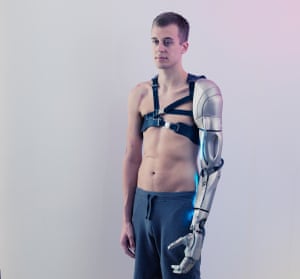
Photograph: David Vintiner
The arm was really made as an artistic project to explore the alternative functions that an arm might have. Those functions worked very well. But because of the nature of my amputation, it has proved kind of a burden to wear. It is very physically demanding.
The project has helped me to understand that it is great to have alternative functions, but it was the core functions that you needed.
Because it was created by artists, there was only so much integration with the body. I am now exploring the further integration, with a bone implant that will allow me to mount an arm on to my skeleton and to be controlled naturally, using brain signals. All of that is obviously very cutting edge, and the NHS can’t afford it – so I’ve been crowdfunding for a year or so. I have £35,000 so far, about half what I need.
If I’m honest, probably the main way the arm has changed my life is by opening conversations, and opening doors to what is actually possible.
I can accept that I am never going to have a bionic arm as good as a human arm. But I am excited to contribute to that push to get it as good as it can be. I like to use the canvas of my body as an opportunity.
Neil Harbisson, cyborg artist
Born with a rare condition that means he can only see the world in black and white, Harbisson – who was born in Britain but grew up in Catalonia – had an antenna implanted in his skull in 2004. This translates the colour spectrum into different vibrations, enabling him to “hear” colours.
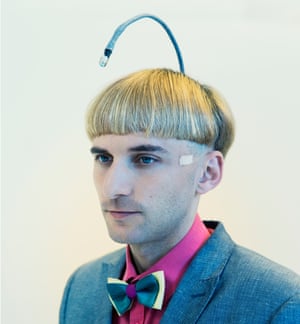
Many people think that I had a problem, and that is why I created the antenna. It was more that I was curious to experience anything around me that I cannot sense. That included colour. But it also now includes infrared and ultraviolet, which I can also receive.
Since I had the antenna, I feel more connected to reality but also to other species and to nature.
If you create a new sense, your brain creates the intelligence to understand it. In the beginning, what I was hearing was chaotic. It slowly became information that I could understand, and then it became perception.
Later, I started having feelings for different colours. My favourite colour is infrared, which is invisible to humans. It has a very low frequency and is calm.
I define myself as transspecies because the definition of human no longer contains me. A human does not have an antenna as a body part, a human does not have infrared and ultraviolet perception. But these are senses and organs that other species have and I feel a connection to them.
If I see many bees going to a specific flower, I understand why because there is such a high level of ultraviolet on that flower.
I think that, eventually, all humans will want that sense too.
Tiana Sinclair, mindwave technology
A researcher into computer science, linguistics and visual culture, Tiana Sinclaircreates events to explore transhuman advances. In the picture below she is demonstrating mindwave technology, which converts the energy of focused attention in the brain through a headset to control external objects, in this case to raise a drone from the ground.
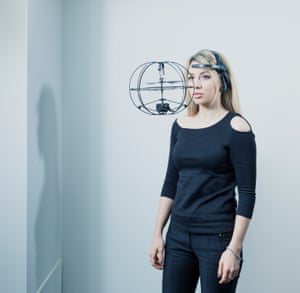
Photograph: David Vintiner
Wearable tech has reached a level of acceptance in terms of health and fitness – the next stage will be all about interfaces. In the future you will press a button to send a signal to one part of your brain or another to help you concentrate to play the flute, or learn a language, by enhancing energy in that area. Electromagnetic stimulators of the mind can create the kind of effect we use every day when we drink coffee or whatever.
At one of the conferences that I organise, we did a couple of demonstrations of what was possible: in one you played ping pong with a headset using your brain; in the other we had a drone which was operated by mindwave. The idea is to bypass the need for a console. You have to be in a state of mind which is not too relaxed and not too concentrated. Once this technology becomes developed in the mainstream, there are many possibilities: already there are artificial limbs that are beginning to be controlled in this way.
Rob Spence, the Eyeborg project
A documentary film-maker who lost his eye in a childhood accident, Rob Spencehad a camera and transmitter fitted into his eye socket in 2009, enabling him to record and transmit video.
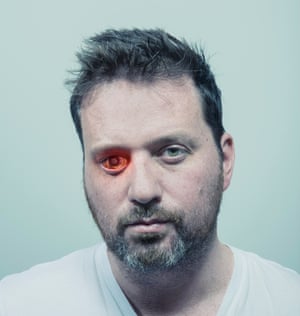
Photograph: David Vintiner
I am quite big with one-eyed people. Moms email me when their kid has lost an eye in an accident, and explain how they say: “Look at this guy, Billy, isn’t that cool”. But for every mom like that, there’s someone else saying: “You are invading our privacy.” Glasshole, I get called. A lot of people believe it is creepy to have a video feed of your life – though as the cyborg anthropologist Amber Case argues, our smartphones have made us all cyborgs really. Everyone is wired now.
The ultimate goal would be to hook up the camera with the brain somehow. There are a few companies trying that. Some have tried to put a chip on the retina, which gives you a very light and bright representation of reality. Other work is being done to create an artificial retina which can decode the information the eye sends to the brain.
Tech companies don’t seem interested in commercialising the Eyeborg. A guy at Apple sent me back an email saying “please piss off”. I think he thought it would damage his credibility if he associated with me. There is a bit of “bearded lady” involved with this still. Some think it’s great, others see it as a freakshow.
Christian Zöllner, Eyesect helmet
Zöllner is part of Berlin-based design collective the Constitute, which runs immersive, homemade sensory experiments. Eyesect is a helmet with mounted cameras that lets you “see” the world as other species would.

Because your eye has been in the same position on your head since before you were born, you’re connected to your environment in a particular way. All the motion of your muscles is dictated by that visual field. When you tinker with that some people get dizzy, fall over or even faint because the disruption is so intense. We’ve experimented with the micro-cameras that you put inside your body for certain medical procedures, and for a low budget it was really stunning.
Everyone reacts differently. It is like acid without acid, your whole physical situation is suddenly not safe any more. You can’t walk in a straight line but you can concentrate on what you are experiencing. We started out trying to create the visual experience of a chameleon, but the most successful is the eyesect vision of a horse. Experiencing having eyes on the side of your head is very alien – but fun to explore.”
Source:-theguardian.



